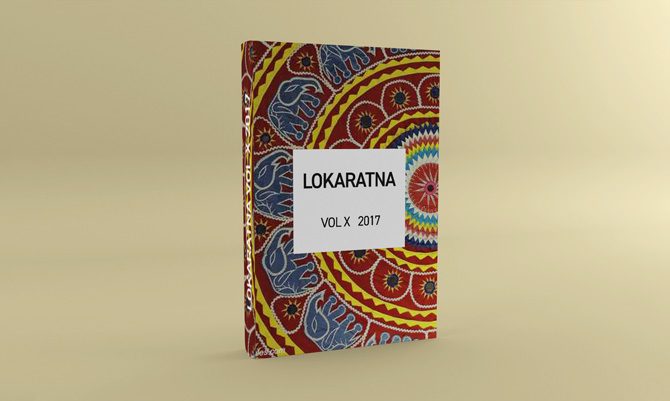Lokratna Volume - X 2017
- Home
- lokaratna

Year of Publication: 2017
ISSN No. 2347-6427
From the Desk of the Editor-in-Chief
Lokaratna completed its ten years. Hundreds of professional and scholars across the globe have contributed to this e journal in the disciplines of humanities, social science, linguistics,folklore, tribal studies,social history and cultural studies.
Mean while an Advisory Board for the journal has been set up and the Editorial Board has also been expanded. Permanent web site for folklore foundation has also been hosted. The site is: www.folklorefooundation.org. All the past issues of Lokaratna have been uploaded in the web site of Folklore Foundation. The web master Mr. Shibaram Mishra has taken much time and energy to make this web site compatible to the web site of any other global institute. He has voluntarily agreed to maintain the web site from time to time to update the readers on folklore
studies. In the mean time the field members of Folklore Foundation have completed the Odisha Volume of People’s Linguistic Survey of India. About 200 people of Odisha from different ethnic groups across the state have completed the volume which contains 40 spoken languages, Odia and Santali as scheduled languages. Rest of the languages is non- scheduled. The Sambalpuri/Koshali language from Western Odisha and Ho language from north Odisha have been recommended by the state government to be included in the VIIIth schedule of the Constitution of India.
Till now 38 spoken but nonscheduled languages have been enlisted for recognition with the government of
India. Sahitya Akademi, New Delhi under its Centre for Oral and Tribal Literature in the Sahitya Akademy under the leadership of Padmashree Anvita Abbi, has released books on oral tradition and Unwritten languages. On 5th April, 2017 Kapila Folklore Foundation, India, Lokaratna Vol. X, 2017 ISSN No. 2347-6427 www.folklorefoundation.org / mkmfolk@gmail.com Vatsayan released two books. One titled Kalahandi ki Vachik Mahakavya ( Oral
Epics of Kalahandi ) in Hindi and another- the compilation the articles of a Seminar on Unwritten Languages held in the literature festival of 2015 in the Sahitya Akademi- titled “Unwritten Languages.
” I visited International Mother Language Institute,(IMLI) Bangladesh on 21st February 2017 and took part in the international seminar on language documentation and multilingual education. The role of Bangladesh in nurturing the mother tongues, especially minority languages is crucial. It is to be remembered that, Banladesh is a country emerged from the struggle for mother tongue. In context, not with in the country itself, the role of IMLI in fostering the minority and endangered languages in Asian countries is highly commendable. I congratulate Prof Zinnat Imtiaz Ali, Director General, IMLI for his untiring efforts to serve for the cause of minority languages.
Language and culture survives, even after the environmental change occurs in human civilization. Stories and songs , proverbs and ritual myths are still alive containing the narratives of 3000 years old civilization. The cultural continuity of human memory retains the oral , performative and visual form even after the material loss is occurred , but the memory and imagination still survive in the memory. The best examples of this are the culture hero Rama, Krishna and Shiva. These three gods are still alive in the public memory when their geographical territories are still uncertain.
The Xth volume of Lokaratna is released to day. This contains the history of ten years of voluntary labour, and to celebrate that the modern technology has facilitated to connect from one end of the globe to the other. Many people use to say that the purity of folk culture will be corrupted by the intrusion of modern technology. Looking this from other point of view, it is safely said that the use of technology for promotion of folklore and culture , and also documenting the original form in performance could be the best way to restore the history of Folklore Foundation, India, Lokaratna Vol. X, 2017 ISSN No. 2347-6427 www.folklorefoundation.org / mkmfolk@gmail.com time in the context of people’s performance of knowledge in their community. The written cannot capture the thought, but the visuals can capture the expression and its details while performance. Thus either it is performance by the people or
research by the scholars, technology has played a major role in sustaining and disseminating the past for future.
I am thankful to all the writers and the reviewers of this volume who have sincerely contributed to this journal.
We are committed to take more thematic work through Folklore Foundation. In future, I hope all those who have contributed to this volume will support the cause by sensitising the new writers as well as the established for a cultural inheritance.
I thank Prof Anand Mahanand, EFLU for his tireless work and support and management of the journal. I also congratulate the new members of editorial board and the advisory board to be with us for a sincere a
Table of Content
Memory, Orality, Literacy and Translation
~ Jayita Sengupta
Tracing the History and Evolution of Palaigital Technology
~ Umesh Patra
Ramayana to Lok Ramayana: an Act of Contemporizing Sacred Texts through Lok(cal) Practice
~ Kapil Sagrolikar
Complementary Nature of ‘Oral’ and ‘Written’ Literature: Application of Ruth Finnegan’s Idea on Maharashtrian
Folk Art~ Banekar Tushar
Chaiti Ghoda Nacha:A Glorious Chapter of Odishan Folk Culture
~ Ashis Mahapatra
Feminization of Folk Art: A Case Study of Patta Painting of Odisha
~ Mamata Dash
Gantha ra Katha The Quilting Tradition from Ganjam, South Odisha
~ Pankaja Sethi
Tribal Customary Marriage Practices Among the Major Tribes of South Odisha- An Ethnographic Approach
~ T Akshyaya Kumar Liza Swain
Folk Tradition in Chettikulangara, with Special Reference to the Ritual Art form of Chettikulanagara Kuthiyottam
~ Priya Soman Sidhharta,M
Irony in Context: A Study of Popular Russian Expressions in Soviet Era
~ Rashmi Kumari Jha
Kirat Myths in Some Indian Nepali Poems
~ Suman Bantawa


